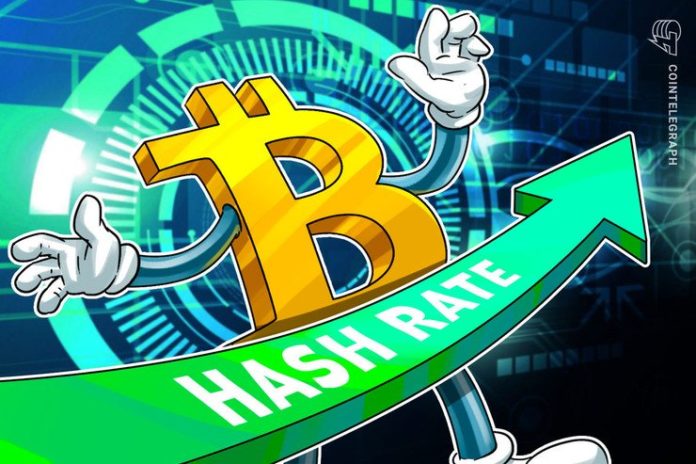[ad_1]
On Saturday Bitcoin (BTC) price dropped below $9,000 again, increasing the uncertainty surrounding future price estimates and reminding investors that the Coronavirus continues to impact markets across the world.
Cryptocurrency market daily performance. Source: Coin360
Interestingly, Bitcoin’s hash rate reached an all-time high on March 5 – 157 quintillion hashes per second – according to the available data from Coin Dance. This increase has been the pattern since the start of this year.
Hash rate represents the computational power that Bitcoin miners need to employ to confirm transactions on the blockchain. The increase in hash rate represents higher security in the network, a trend that has been consolidated in recent years, ultimately increasing confidence for potential investors in Bitcoin.

Hash Rate (quintillion hashes per second) from Jan. 2016 – Mar. 2020. Source: Bitinfocharts
The relationship between the hash rate and the future Bitcoin price have been discussed as well as other events related to miners, such as the upcoming Bitcoin halving which will see the BTC reward per block created by miners cut in half.
The next halving event, likely to occur on May 20, 2020, raises additional questions on the behavior of miners that day and the relationships with the price for the foreseeable future amid the increasing hash rate trend.
What insight does the 2016 halving provide for 2020?
The last Bitcoin halving event occurred on July 9, 2016, when the digital asset’s closing price dropped from $666.52 to $650.96 on the halving day, a negative return of 2.36%.
Bitcoin price ended up losing 7.5% that month, however, from July until the end of 2016, the price gained more than 35% ending the year at $963.74 on December 31.

Bitcoin Price (in USD) during July 2016. Source: Coinmarketcap.com
At the same time, the hash rate increased on the halving day to 1.5606 quintillion hashes per second from 1.4978 quintillion hashes per second on July 8, 2016. Miners’ profitability per hash is naturally reduced since to obtain the same amount of BTC as before, miners will have to spend at least twice the power input as before from that day onward.

Hash Rate (quintillion hashes per second) during July 2016. Source: Bitinfocharts
Similar price action and hash rate evolution during Bitcoin Cash fork
The Bitcoin Cash (BCH) fork on August 1, 2017, is another example of an event directly impacting miners. As seen before in the 2016’s halving event, Bitcoin’s return on that day was negative at -5.62%, with the price dropping from $2,875.34 on July 31 to $2,718.26 on the day of the hard.

Bitcoin Price during July and August 2017. Source: Coinmarketcap.com
Contrarily to 2016, during the month of the event – in this case, August – saw a great positive return at 49.2%. The remainder of the year saw Bitcoin reaching a record high price at over $20,000 which is 159% higher than from August until the end of the 2016.
When it comes to the hash rate, it increased from July 31 (6.30 quintillion hashes/second) to Aug. 1 (6.44 quintillion hashes/second) – this was the opposite behavior to the last halving event’s hash rate evolution. Nevertheless, until the end of the year, the positive growth trend for the hash rate continued.

Hash Rate (quintillion hashes per second) during July and August 2017. Source: Bitinfocharts
Strong correlation between Bitcoin price and hash rate
Across the years, the correlation between the Bitcoin price and the hash rate has been very high, suggesting a relationship between the two variables. In 2016, these two variables were correlated at 86.2%, while in 2017 the relationship was even greater at 91.5% – the highest across from 2016-2020.
However, in 2018, a high opposite relationship was observed between hash rate and Bitcoin price at negative 66.2%, being the only year with a negative correlation between these variables. Naturally, the positive relationship was again shown in 2019 with a correlation of 59.5%.

Correlation between Bitcoin price and its hash rate
A correlation of 100% means that the Bitcoin price and hash rate move completely in the same direction, while -100% correlation means they are inversely related. A correlation of 0% means that the variables are not related in any way.
Data shows a significant negative relationship between hash rate and returns
When employing regression models to determine the influence of hash rate on Bitcoin’s price, one can observe conflicting non-significant results, meaning we cannot reach a conclusion about the behavior in individual years with a slight exception in 2019.
During 2019, there was a very small significant negative relationship between the hash rate and Bitcoin’s price, meaning when the hash rate increased by 1%, Bitcoin’s price would reduce by 0.01%.
A small positive during the last halving event month
During July 2016, the month of the last halving event, there was a small positive significant relationship between the hash rate and Bitcoin returns – when the hash rate increased by 1%, Bitcoin returns would increase by 0.018%, in the same line as the positive cumulative return during that month as well as the hash rate increasing trend.
Outlook for the upcoming 2020 halving
Bitcoin will experience its next halving event in approximately 64 days and the block reward for miners will be cut in half from 12.5 BTC to 6.25 BTC. It is commonly assumed that miners tend to sell before the halving event due to the decrease in the rewards, which could hurt Bitcoin’s price shortly before the event.
As hash rates keep reaching record-highs and its relationship with halving events mimic the upward continuous trend, investors may face a short-term price decrease but focusing on the previous medium to long-term horizons shows a recovery in the case of both mining-related events.
Data for the hash rate drawn from bitinfocharts.com. The views and opinions expressed here are solely those of the author and do not necessarily reflect the views of Cointelegraph. Every investment and trading move involves risk. You should conduct your own research when making a decision.
[ad_2]










